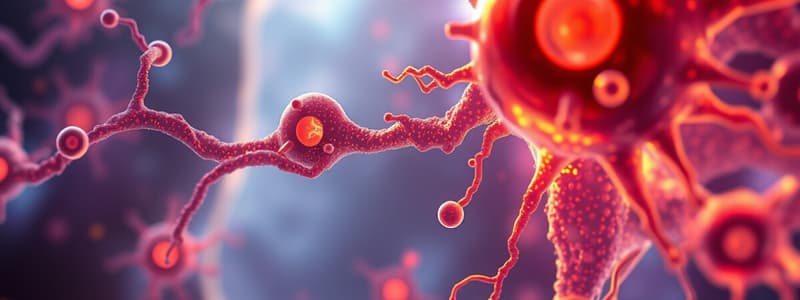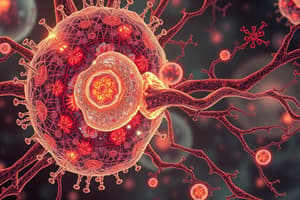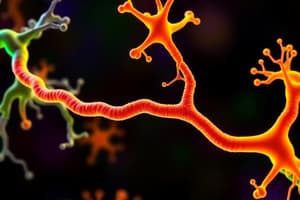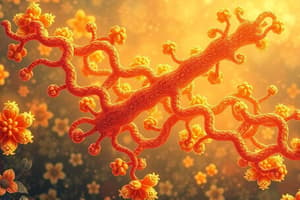Podcast
Questions and Answers
What occurs during the activation of ligand-gated ion channels?
What occurs during the activation of ligand-gated ion channels?
- An agonist binding leads to a brief opening of the channel. (correct)
- The channel opens, allowing potassium influx only.
- The receptor is activated, causing the pore to close.
- The channels remain open continuously.
What is the role of G proteins when GTP is bound to the α subunit?
What is the role of G proteins when GTP is bound to the α subunit?
- They can only activate ion channels but not enzymes.
- They remain inactive and bound to the receptor.
- They only inhibit target enzymes without activating them.
- They dissociate into α–GTP and βγ subunits for further signaling. (correct)
Which structural components characterize ligand-gated ion channels?
Which structural components characterize ligand-gated ion channels?
- Three subunits interacting directly without a pore.
- Two subunits forming a tunnel for ion passage.
- Five subunits arranged around a central pore. (correct)
- A single subunit forming a closed channel.
What is the function of Gs proteins in the signaling pathway?
What is the function of Gs proteins in the signaling pathway?
During resting state, G proteins are in what configuration?
During resting state, G proteins are in what configuration?
What is the primary cause for the opening of the pore in ligand-gated ion channels?
What is the primary cause for the opening of the pore in ligand-gated ion channels?
What happens after an agonist binds to G protein-coupled receptors?
What happens after an agonist binds to G protein-coupled receptors?
What is the effect of stimulation of the nicotinic acetylcholine receptor?
What is the effect of stimulation of the nicotinic acetylcholine receptor?
What is the primary function of an agonist in relation to a receptor?
What is the primary function of an agonist in relation to a receptor?
Which type of receptor requires the ligand to be lipid soluble to enter and exert its effects?
Which type of receptor requires the ligand to be lipid soluble to enter and exert its effects?
Which type of enzyme-linked receptor is most commonly associated with signal transduction in cells?
Which type of enzyme-linked receptor is most commonly associated with signal transduction in cells?
Which G protein is associated with inhibiting adenyl cyclase and decreasing cAMP levels?
Which G protein is associated with inhibiting adenyl cyclase and decreasing cAMP levels?
What is the role of diacylglycerol (DAG) in cellular signaling?
What is the role of diacylglycerol (DAG) in cellular signaling?
Which second messenger is primarily increased following Gq activation that stimulates calcium release from the sarcoplasmic reticulum?
Which second messenger is primarily increased following Gq activation that stimulates calcium release from the sarcoplasmic reticulum?
Which of the following best describes the structure of enzyme-linked receptors?
Which of the following best describes the structure of enzyme-linked receptors?
What is the effect of a ligand binding to intracellular receptors?
What is the effect of a ligand binding to intracellular receptors?
Which of the following statements best describes the function of receptor agonists?
Which of the following statements best describes the function of receptor agonists?
What characterizes G protein-coupled receptors (GPCRs)?
What characterizes G protein-coupled receptors (GPCRs)?
What is the primary mechanism of action for enzyme-linked receptors?
What is the primary mechanism of action for enzyme-linked receptors?
Which type of receptor is primarily responsible for the rapid response to neurotransmitters?
Which type of receptor is primarily responsible for the rapid response to neurotransmitters?
What role do antagonists play in drug-receptor interaction?
What role do antagonists play in drug-receptor interaction?
How do membrane receptors transduce signals into cells?
How do membrane receptors transduce signals into cells?
What defines the affinity of a drug to a receptor?
What defines the affinity of a drug to a receptor?
What type of chemical action can specifically neutralize gastric acid in the treatment of peptic ulcers?
What type of chemical action can specifically neutralize gastric acid in the treatment of peptic ulcers?
Flashcards are hidden until you start studying
Study Notes
Intracellular Receptors
- Located entirely within the cytoplasm, requiring ligands that can diffuse through the plasma membrane.
- Ligands must be lipid-soluble to interact with these receptors.
- Binding influences gene expression, either inducing or suppressing it.
- Examples include steroid hormone receptors.
Ligand-Gated Ion Channels
- Also known as ionotropic receptors, typically formed by five subunits (2α, β, γ, δ) around a central channel.
- The ligand binding site is on the extracellular portion, regulating the central transmembrane pore.
- Channels remain closed until activated by an agonist, allowing ion flow for milliseconds.
- Function varies by ion; e.g., nicotinic receptor stimulation by acetylcholine leads to sodium influx and potassium outflux, causing muscle contraction.
G Protein-Coupled Receptors (GPCRs)
- Referred to as metabotropic receptors, characterized by a ligand binding site externally and G protein interaction internally.
- G proteins are trimeric (α, β, γ) and couple with the receptor.
- In resting state, G proteins bind GDP; agonist binding triggers GDP-GTP exchange, activating the G protein.
- Activated G protein dissociates into α-GTP and βγ subunits, influencing various enzymes and ion channels.
Types of G Proteins
- Gs: Activates adenyl cyclase, increasing cAMP, leading to protein kinase A (PKA) activation and enhanced heart contractions (e.g., β1 receptors).
- Gi: Inhibits adenyl cyclase, decreasing cAMP, thus reducing enzyme activities and protein phosphorylation (e.g., α2 receptors).
- Gq: Activates phospholipase C, increasing inositol triphosphate (IP3) and diacylglycerol (DAG) levels, resulting in elevated intracellular calcium and protein kinase C (PKC) activity (e.g., α1 receptors).
Enzyme-Linked Receptors
- Composed of an extracellular binding domain and a cytoplasmic enzyme domain, often a protein tyrosine kinase.
- The two domains are connected by a hydrophobic segment that spans the plasma membrane.
- Insulin receptors are common examples of enzyme-linked receptors.
Agonists and Pharmacodynamics
- Agonists bind to receptors and evoke a biological response, possessing both affinity and intrinsic activity.
- Pharmacodynamics explores how drugs act at various biological targets, starting from binding to receptors or proteins.
Mechanisms of Drug Action
-
Non-Receptor Mediated Actions:
- Physical: E.g., activated charcoal used in diarrhea.
- Chemical: E.g., antacids neutralizing gastric acidity.
- Enzymatic: E.g., neostigmine inhibiting acetylcholinesterase.
-
Receptor Mediated Actions:
- Involves specific binding to receptor surfaces, initiating intracellular effects.
- Affinity defines a drug's binding strength; intrinsic activity indicates effectiveness in provoking response.
Drug-Receptor Interaction
- Described as a "lock and key" model, where drugs (keys) fit specific receptors (locks), leading to activation or inhibition.
- Two main types of receptors:
- Membrane Receptors:
- Transmembrane ligand-gated ion channels.
- Transmembrane G protein-coupled receptors.
- Enzyme-linked receptors.
- Membrane Receptors:
Studying That Suits You
Use AI to generate personalized quizzes and flashcards to suit your learning preferences.




